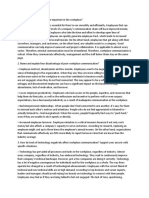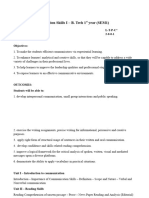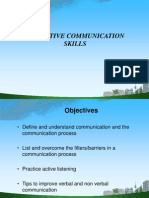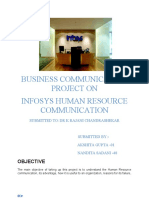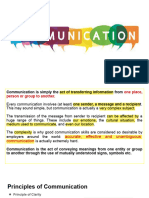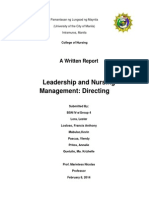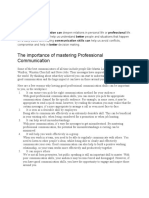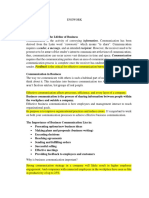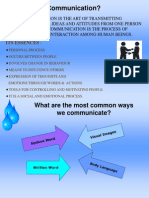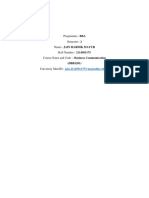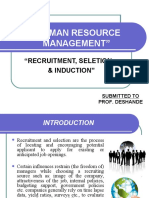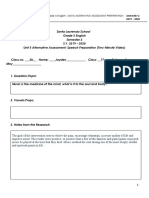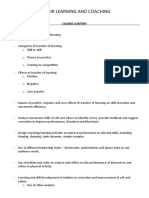Socializer (Open and Direct) 3. Relater (Open and Indirect)
Socializer (Open and Direct) 3. Relater (Open and Indirect)
Uploaded by
Shahezad NathaniCopyright:
Available Formats
Socializer (Open and Direct) 3. Relater (Open and Indirect)
Socializer (Open and Direct) 3. Relater (Open and Indirect)
Uploaded by
Shahezad NathaniOriginal Title
Copyright
Available Formats
Share this document
Did you find this document useful?
Is this content inappropriate?
Copyright:
Available Formats
Socializer (Open and Direct) 3. Relater (Open and Indirect)
Socializer (Open and Direct) 3. Relater (Open and Indirect)
Uploaded by
Shahezad NathaniCopyright:
Available Formats
INTRODUCTION The word communication is used in common talk, to mean speaking or writing or sending a message to another person.
. Communication involves ensuring that your message has reached the target audience. The receiver should understand and respond to you. Communication is an important aspect of behaviour. WHAT IS THE ROLE OF COMMUNICATION AT WORKPLACE? Excellent communication skill Development of any healthy relationship Holding organization together Influences the behaviour of an individual WHAT DOES COMMUNICATION AT WORKPLACE INCLUDE? Formality Unintentional Dynamic Systemic
WHAT ARE THE STYLES IN COMMUNICATION AT WORKPLACE? 1. Director (Closed and Direct) 2. Socializer (Open and Direct) 3. Relater (Open and Indirect) 4. Thinker (Closed and Indirect WHAT ARE THE WAYS AND MEANS OF COMMUNICATION AT WORKPLACE? Written and oral One-way and two-way Formal and informal Internal and external Verbal and non-verbal Vertical and horizontal Interpersonal and intrapersonal WHAT ARE THE COMMUNICATION CHALLENGES AT WORKPLACE? Do you ever feel like youre not on the same wavelength as someone you work with? That you dont see eye-to-eye? That youre not speaking the same language? If your answer to any of these questions is "yes," you may be experiencing challenges because of different communication styles.
Businesses come in all shapes and sizes. Some are small, localized operations that have no more than ten employees. Others distribute their goods and services all over the globe using teams of hundreds, sometimes even thousands of employees. Each business, regardless of its size, scope or number of staff members, must be skilled in the art of communication and organization if it is to succeed and generate a profit. Multiple means of communicating Art of communicating with your fellow employees Language and culture obstacles Electronic mail Designation Technology Listening Problem in explaining the conversation Problem in expressing oneself clearly an completely Criticism Problem in expressing gratitude Lack of information Lack of participation
WHAT ARE THE EFFECTS OF COMMUNICATION CHALLENGES AT WORKPLACE? Distrust and low morale Culture clashes Low productivity and customer satisfaction Misunderstandings
WHAT ARE WRITTEN COMMUNICATION CHALLENGES AT WORKPLACE? E-mails not being read Poor writing skills Problem of presenting technical data to non technical people Lack of planning Lack of courtesy Use of phrases instead of single word Lack of proper information
WHAT ARE ORAL COMMUNICATION CHALLENGES AT WORKPLACE? Problem in hearing Lack of listening skill Problem in language
Lack of confidence PROBLEM OF COMMUNICATION IN AN ORGANISATION? Communication within organization, team etc Communication outside with other stakeholders Communication inside the team Problem of understanding People are being left out Low level employees are often ignored Hatred between employer and employee
How to overcome the communication challenges at workplace
Lack of communication between employees is usually the cause of many workplace problems. This may mean there is a lack of communication between supervisors and employees, among employees or between employees and the customers. No matter what the cause of the problems in the workplace, these steps will help you solve them.
Instructions
o
1
Understand that when people in the workplace communicate with each other, they need to make sure that the other person understands what they are hearing. This way, nobody will be able to say, "Oh, I misunderstood" or "Well, no one told me that." When interacting with others, it is often helpful to repeat the key points that you want them to remember.
2
Remember that everyone should always be direct and truthful. Don't imply or exaggerate anything you say; instead be respectful, truthful and direct so that you aren't misunderstood.
3
Have company meetings during which everyone discusses the points made in Steps 1 and 2. The first part of solving workplace problems is prevention--eliminate problems before they begin. Designate a supervisor or supervisors who are responsible for helping people solve problems in the workplace. Next, make it clear that at any time an employee is having a problem, they can visit with these people for help.
o o
4
Solve problems among employees when they arise. First, identify the problem and the facts surrounding it. Second, identify the size and importance of the problem. This might be something with an easy solution. On the other hand, it may be a recurring problem that needs quite a bit of time and attention to solve.
5
Identify the best way to solve the problem. Discuss acceptable solutions to the problems and decide which one is the best. Next, determine the actions needed to reach that solution. You may need to have further meetings, mediation between employees or, in extreme situations, legal action.
Tips & Warnings
Meet with all parties involved in a problem soon after they have attempted to find the solution. Clarify that they are satisfied with the results and that the problem was solved. Don't get angry or confrontational when you are trying to solve a problem in the workplace. Staying calm is always more productive and effective.
Eliminating differences in perception: The organization should ensure that it is recruiting right individuals on the job. Its the responsibility of the interviewer to ensure that the interviewee has command over the written and spoken language. There should be proper Induction program so that the policies of the company are clear to all the employees. There should be proper trainings conducted for required employees (for eg: Voice and Accent training). Use of Simple Language: Use of simple and clear words should be emphasized. Use of ambiguous words and jargons should be avoided. Reduction and elimination of noise levels: Noise is the main communication barrier which must be overcome on priority basis. It is essential to identify the source of noise and then eliminate that source. Active Listening: Listen attentively and carefully. There is a difference between listening and hearing. Active listening means hearing with proper understanding of the message that is heard. By asking questions the speaker can ensure whether his/her message is understood or not by the receiver in the same terms as intended by the speaker. Emotional State: During communication one should make effective use of body language. He/she should not show their emotions while communication as the receiver might misinterpret the message being delivered. For example, if the conveyer of the message is in a bad mood then the receiver might think that the information being delivered is not good.
Simple Organizational Structure: The organizational structure should not be complex. The number of hierarchical levels should be optimum. There should be a ideal span of control within the organization. Simpler the organizational structure, more effective will be the communication. Avoid Information Overload: The managers should know how to prioritize their work. They should not overload themselves with the work. They should spend quality time with their subordinates and should listen to their problems and feedbacks actively. Give Constructive Feedback: Avoid giving negative feedback. The contents of the feedback might be negative, but it should be delivered constructively. Constructive feedback will lead to effective communication between the superior and subordinate. Proper Media Selection: The managers should properly select the medium of communication. Simple messages should be conveyed orally, like: face to face interaction or meetings. Use of written means of communication should be encouraged for delivering complex messages. For significant messages reminders can be given by using written means of communication such as : Memos, Notices etc. Flexibility in meeting the targets: For effective communication in an organization the managers should ensure that the individuals are meeting their targets timely without skipping the formal channels of communication. There should not be much pressure on employees to meet their targets.
Personnel in a workplace communicate with peers, managers, supervisors, members of the public, suppliers and others. Barriers to communication can cause problems and misunderstanding with effective communication. Some barriers to communication are: jargon disabilities age status lack of empathy stereotyping unclear or incomplete messages distance lack of time poor spelling - inaccurate sentence structure.
The following list outlines points to consider in relation to overcoming communication barriers. feedback - enables communication to become a two way process with both the sender and the receiver trying to achieve mutual understanding consider the words used - long complicated sentences and unfamiliar words confuse people. Communication should be clear, complete, concise, concrete, correct and courteous. use repetition - repeating messages several time using different examples can help others to understand the messages being sent use empathy - seeing a situation from another person's viewpoint and trying to understand others opinions concerns and attitudes makes better communicators timing - poor timing can result in messages not being received effectively
being positive rather than negative helps make communication more effective - what is wanted not what isn't wanted select the best location - talk somewhere that will encourage open communication not a noisy shop floor or a busy office listening reduces communication check written communication for spelling errors and ensure the sentences are clear, concise and not ambiguous.
You might also like
- Shapes Lesson PlanDocument10 pagesShapes Lesson Planapi-285768293No ratings yet
- Venus Retrograde in The Birth or Natal ChartDocument3 pagesVenus Retrograde in The Birth or Natal ChartRamram07No ratings yet
- Erving Goffman Behavior in Public Places PDFDocument2 pagesErving Goffman Behavior in Public Places PDFRex0% (2)
- Roger Ballen 1Document36 pagesRoger Ballen 1lukamm100% (2)
- Annotated BibliographyDocument2 pagesAnnotated Bibliographyapi-283741203No ratings yet
- Lead Small TeamsDocument14 pagesLead Small TeamsfirehywotNo ratings yet
- MG Communication For ManagersDocument45 pagesMG Communication For ManagersPravin TejasNo ratings yet
- Session 1 - Effective Communication SkillsDocument22 pagesSession 1 - Effective Communication SkillsBisham HurreeramNo ratings yet
- Employee Communication TrainingDocument5 pagesEmployee Communication TrainingNicole ChimwamafukuNo ratings yet
- Coma 100 - M8Document10 pagesComa 100 - M8Emmanuel D. MalongaNo ratings yet
- IMsBEAUTY CARE AND WELLNESSDocument5 pagesIMsBEAUTY CARE AND WELLNESSJOSEPHINE TEVESNo ratings yet
- ManagementDocument45 pagesManagementsureshchitraNo ratings yet
- Horizontal CommunicationDocument6 pagesHorizontal CommunicationRayhan Morshed100% (4)
- Page 58Document2 pagesPage 58Kathleen ColinioNo ratings yet
- Communication Skills 1Document16 pagesCommunication Skills 1Mayank DwivediNo ratings yet
- Workshop ON Effective Communication SkillsDocument31 pagesWorkshop ON Effective Communication SkillsBilal HussainNo ratings yet
- Eliminating Differences in PerceptionDocument1 pageEliminating Differences in PerceptionSourabh RaoraneNo ratings yet
- Module 14 - Receive & Respond To Workplace CommunicationDocument33 pagesModule 14 - Receive & Respond To Workplace Communicationdesalew bayeNo ratings yet
- Importance of CommunicationDocument9 pagesImportance of CommunicationJimmy TengNo ratings yet
- PDF 20221017 201804 0000 PDFDocument16 pagesPDF 20221017 201804 0000 PDFYelly HazeNo ratings yet
- E1 Csi Sem1 SyllabusDocument124 pagesE1 Csi Sem1 Syllabusedwardmaganga870No ratings yet
- Topic 1 Effective Workplace CommunicationDocument3 pagesTopic 1 Effective Workplace CommunicationCrisnelynNo ratings yet
- Workshop ON Effective Communication Skills: by Prem ChandDocument16 pagesWorkshop ON Effective Communication Skills: by Prem ChandSrinivasan NallathambiNo ratings yet
- Assertive Communication For ManagerDocument4 pagesAssertive Communication For ManagerSasank AravapalliNo ratings yet
- Q.1. What Is A Official Communication?Document17 pagesQ.1. What Is A Official Communication?sdp071660No ratings yet
- PenzuDocument20 pagesPenzusdp071660No ratings yet
- But We Already Have A Company Bulletin To Tell Everyone What Is HappeningDocument6 pagesBut We Already Have A Company Bulletin To Tell Everyone What Is Happeningpratibha_1979No ratings yet
- Effective CommunicationDocument47 pagesEffective Communicationssuman2742No ratings yet
- Effective Communication Skill PPT at Bec Doms MbaDocument16 pagesEffective Communication Skill PPT at Bec Doms MbaBabasab Patil (Karrisatte)100% (3)
- Effective Communication in A WorkplaceDocument4 pagesEffective Communication in A WorkplaceUgochi arumNo ratings yet
- Barriers of CommunicationDocument6 pagesBarriers of Communicationgeethrk12No ratings yet
- The Essential of Effective Communication FinalDocument13 pagesThe Essential of Effective Communication FinalInaamduggalNo ratings yet
- HR Comm in InfosysDocument28 pagesHR Comm in InfosysNandita SadaniNo ratings yet
- Managerial CommunicationDocument17 pagesManagerial Communicationbadree456No ratings yet
- Communication in The Office IDocument29 pagesCommunication in The Office IOh Huda100% (1)
- Module 1 - Lesson 7Document5 pagesModule 1 - Lesson 7GILBERTNo ratings yet
- Communication Skills NotesDocument27 pagesCommunication Skills NotesAndleeb juttiNo ratings yet
- Lecture 15 Effective Communications in HRMDocument50 pagesLecture 15 Effective Communications in HRMGoodness GodwinNo ratings yet
- Developing Communication SkillsDocument6 pagesDeveloping Communication SkillsTalha ShaukatNo ratings yet
- Communication GapDocument15 pagesCommunication GapPreeti MongaNo ratings yet
- Mba 401Document10 pagesMba 401AnuSinghNo ratings yet
- Unit-2 Full NotesDocument22 pagesUnit-2 Full NotesDileep S SNo ratings yet
- Why Are Interpersonal Skills Important?: Develop Interpersonal Skills at Work - It Is Rightly Said That A SmartDocument37 pagesWhy Are Interpersonal Skills Important?: Develop Interpersonal Skills at Work - It Is Rightly Said That A SmartEhsan ShNo ratings yet
- Assignments CSDocument7 pagesAssignments CSNaresh VitNo ratings yet
- CommunicationDocument25 pagesCommunicationamishachandravanshi17No ratings yet
- Business Communication 2.0 FinalDocument11 pagesBusiness Communication 2.0 FinalHardik JainNo ratings yet
- Nursing Management-DirectingDocument31 pagesNursing Management-DirectingFrancis Anthony LoslosoNo ratings yet
- Business Skills: Project Management, Leadership, and Startup KnowledgeFrom EverandBusiness Skills: Project Management, Leadership, and Startup KnowledgeNo ratings yet
- The Importance of Mastering Professional CommunicationDocument5 pagesThe Importance of Mastering Professional CommunicationManisha ShakyaNo ratings yet
- All Modules ENGWORKDocument39 pagesAll Modules ENGWORKJoker 27No ratings yet
- Topic 6 Communication in The OfficeDocument38 pagesTopic 6 Communication in The OfficesyakirahNo ratings yet
- Business Communication NotesDocument55 pagesBusiness Communication NotesAditya vijayvargiyaNo ratings yet
- What Is Effective Workplace CommunicationDocument2 pagesWhat Is Effective Workplace CommunicationThomas Dave Linao AgravanteNo ratings yet
- Communication GapDocument5 pagesCommunication GapAnis ur RehmanNo ratings yet
- Communication Is An Important Facet of LifeDocument10 pagesCommunication Is An Important Facet of LifeNikhil Malhotra100% (2)
- Receive and Respond To Work Place CommunicationDocument13 pagesReceive and Respond To Work Place Communicationangellibres20No ratings yet
- What Is Communication?: Its EssencesDocument12 pagesWhat Is Communication?: Its EssencesRakesh TalwarNo ratings yet
- Business Communication FinalDocument11 pagesBusiness Communication FinalHardik JainNo ratings yet
- MT123 Business CommunicationDocument22 pagesMT123 Business CommunicationShantanu JahagirdarNo ratings yet
- Mizan Atvet College: Participating in Workplace CommunicationsDocument18 pagesMizan Atvet College: Participating in Workplace CommunicationsYaread bitewNo ratings yet
- PurposiveCommunication Week16Document5 pagesPurposiveCommunication Week16Anne AladadNo ratings yet
- The Adverse Effects of Poor CommunicationDocument6 pagesThe Adverse Effects of Poor CommunicationPml F LarkanaNo ratings yet
- Effective Communication at Work: Say what you mean and get what you wantFrom EverandEffective Communication at Work: Say what you mean and get what you wantNo ratings yet
- Business Skills: The Essentials of Leadership, Project Management, and FinanceFrom EverandBusiness Skills: The Essentials of Leadership, Project Management, and FinanceNo ratings yet
- Security AnalysisDocument5 pagesSecurity AnalysisShriya GuptaNo ratings yet
- Rural Marketing PepsiDocument24 pagesRural Marketing PepsiShahezad NathaniNo ratings yet
- "Human Resource Management": "Recruitment, Seletion & Induction"Document36 pages"Human Resource Management": "Recruitment, Seletion & Induction"Shahezad NathaniNo ratings yet
- Recruitment and SelectionDocument39 pagesRecruitment and SelectionMithun SahaNo ratings yet
- Cafe Coffe DayDocument3 pagesCafe Coffe DayShahezad NathaniNo ratings yet
- By Lauren Caskie & Jen BarrDocument11 pagesBy Lauren Caskie & Jen BarrShahezad NathaniNo ratings yet
- Jayden Alexander Tirta - Speech PreparationDocument5 pagesJayden Alexander Tirta - Speech PreparationJAYDEN ALEXANDER TIRTANo ratings yet
- Delusional Disorder - An OverviewDocument12 pagesDelusional Disorder - An Overviewdrrlarry100% (1)
- Afrouz, Maidi Et Al. 2018Document8 pagesAfrouz, Maidi Et Al. 20182013_10_33_03_11_164No ratings yet
- Business English - Unit 1 - Week 1Document16 pagesBusiness English - Unit 1 - Week 1Hakooma Righteous MNo ratings yet
- Turkle Relational ArtifactsDocument0 pagesTurkle Relational ArtifactsKika NicolelaNo ratings yet
- Behavioral Finance 2021Document118 pagesBehavioral Finance 2021Frizzy Hair100% (1)
- DialogueDocument18 pagesDialoguenoronisa talusobNo ratings yet
- MeditationDocument11 pagesMeditationArctic IllusionNo ratings yet
- BubullyingDocument6 pagesBubullyingBenson DongiaponNo ratings yet
- Types of ReliabilityDocument6 pagesTypes of ReliabilityAbraxas LuchenkoNo ratings yet
- Lesson - Plan Personal DevelopmentDocument5 pagesLesson - Plan Personal DevelopmentLady Rhose MapaitNo ratings yet
- Section 1 Questions 1-5Document4 pagesSection 1 Questions 1-5jcgxchchNo ratings yet
- References BootaDocument15 pagesReferences BootaHaider SarwarNo ratings yet
- The Doris Fischer Case of Multiple PersonalityDocument79 pagesThe Doris Fischer Case of Multiple PersonalityAscending Agondonter100% (1)
- Job Analysis and Profile MatchingDocument30 pagesJob Analysis and Profile MatchingKashvi ShahNo ratings yet
- Group 5 MaleDocument6 pagesGroup 5 MaleAdriano Zyrus BalalloNo ratings yet
- M2Scientific Investigation Entrepreneurship Research ProcessDocument13 pagesM2Scientific Investigation Entrepreneurship Research ProcessKanae KawaiiNo ratings yet
- Motor Learning + Coaching - ContentDocument13 pagesMotor Learning + Coaching - ContentxanaduNo ratings yet
- Learning Competency/ies: (Taken From The Curriculum Guide) Key Concepts/ Understandings To Be Developed 1. ObjectivesDocument2 pagesLearning Competency/ies: (Taken From The Curriculum Guide) Key Concepts/ Understandings To Be Developed 1. ObjectivesLubeth Cabatu67% (3)
- Chapter 30: Neurodevelopmental, Behavioral and Mental Health Disorders Garzon Maaks: Burns' Pediatric Primary Care, 7th EditionDocument6 pagesChapter 30: Neurodevelopmental, Behavioral and Mental Health Disorders Garzon Maaks: Burns' Pediatric Primary Care, 7th EditionHelen UgochukwuNo ratings yet
- Seeking Finding HealingDocument174 pagesSeeking Finding HealingNAVEED E SABANo ratings yet
- Unit Assessment Plan TemplateDocument5 pagesUnit Assessment Plan Templateapi-393560881No ratings yet
- Staff Nurse Interview Questions 2Document3 pagesStaff Nurse Interview Questions 2daciana_ilie100% (2)
- Course Design PRINCIPLES OF PUBLIC SPEAKINGDocument8 pagesCourse Design PRINCIPLES OF PUBLIC SPEAKINGCik IntanNo ratings yet
- Math Anxiety DissertationDocument5 pagesMath Anxiety DissertationWriteMySociologyPaperUK100% (1)













